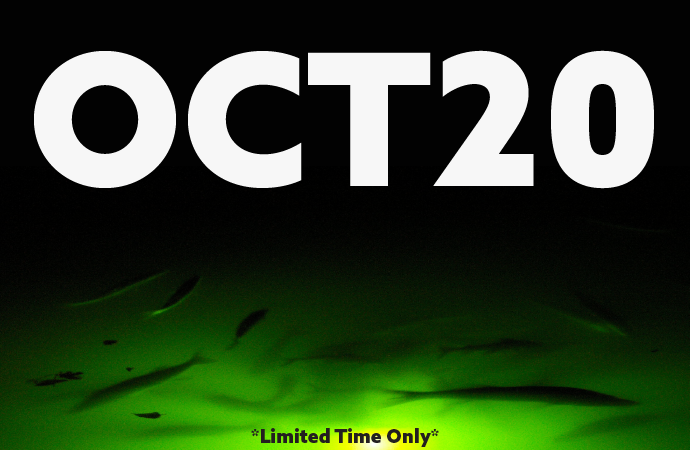How Bright Does An Underwater Fish Light Need To Be?

Understanding Fish Lights: A Guide to Choosing the Right Option for Your Dock
To understand how fish lights work, we must explore their fundamental scientific principles. While these lights may seem magical in their ability to attract fish, their function is rooted in simple science. When a light is placed underwater, it illuminates and reflects off particles suspended in the water. This creates an attractive glow that draws bait fish. These bait fish, in turn, attract larger predator fish, such as snook, tarpon, redfish, and ladyfish in saltwater environments. Similarly, in freshwater settings, you might see bass, crappie, and carp. The light essentially creates a chain reaction, starting with the smallest creatures and culminating in the arrival of larger game fish.
Considering Brightness: The Role of LED and HID Lights
When evaluating the brightness of a fish light, several factors must be taken into account, starting with the type of light. Some fish light manufacturers use LED lights for their dock systems, primarily due to their energy efficiency and longevity. While LEDs are relatively bright compared to typical household lights, they often fall short when tasked with lighting large underwater areas effectively. This limitation can make them less than ideal for docks where expansive illumination is desired.
Another significant drawback of LED lights is their inability to self-clean. Unlike HID (High-Intensity Discharge) lights, LEDs do not generate heat. This lack of heat allows aquatic growth, such as barnacles and algae, to accumulate on the light’s surface. Over time, this buildup can block the light and reduce its effectiveness, eventually rendering it useless unless it is cleaned manually. For these reasons, LED lights struggle to meet the demands of underwater dock lighting.
HID Lights: The Superior Choice
For permanent dock installations, HID lights are the better choice. These bulbs are not only over 300% brighter than LEDs but also come with the added benefit of being self-cleaning. The heat generated by HID lights prevents the buildup of aquatic growth, keeping the bulb clear and operational for extended periods. This self-cleaning ability makes HID lights highly efficient and low-maintenance.
High-quality HID fish lights are typically equipped with a photocell. This device automates the light, turning it on at dusk and off at dawn. The consistent operation of the light ensures that it remains clean and free from barnacles and algae. Moreover, the regular schedule helps establish a feeding cycle for fish. Over time, fish learn to associate the light with a reliable food source, encouraging them to return to your dock night after night. This feature not only enhances the fishing experience but also fosters a vibrant underwater ecosystem.
Choosing the Right Wattage
Once you’ve decided to use HID lights, the next step is to determine the appropriate wattage for your needs. The choice largely depends on two factors: the clarity of your water and your personal preference for the amount of light you want. HID fish lights generally come in two wattage levels: 175 watts and 250 watts.
- 175-Watt Natural Green Light: This entry-level option produces a light circle with a diameter of approximately 10 feet. It is ideal for docks with clear to moderately clear water. For customers with good water clarity, the 175-watt bulb often provides sufficient light and attracts a wide variety of fish.
- 250-Watt Vibrant Green Light: For docks with darker or murkier water, the 250-watt light is the better choice. This bulb is 50% brighter than the 175-watt option and over 400% brighter than most LED lights. It produces a light circle with a diameter of about 15 feet, offering enhanced visibility and a broader range for attracting fish. Many customers also opt for the 250-watt light simply because they want to cover the largest possible area around their dock.
Customizing Your Setup
It’s important to note that there is no universal standard for dock lighting. Each dock and water environment is unique, and what works perfectly for one customer may not suit another. For some, the 175-watt light is sufficient to attract hundreds of fish, even in moderately clear water. For others with darker conditions or a preference for maximum coverage, the 250-watt light is the best choice.
Additionally, water clarity doesn’t always dictate the need for a brighter bulb. Many customers choose the 250-watt light even in clear water simply to achieve a larger area of illumination. This flexibility allows you to tailor your setup to your specific needs and preferences.
Key Questions to Ask
Selecting the right underwater fish light is not an exact science. Ultimately, the best choice depends on your unique requirements and expectations. To make an informed decision, ask yourself two key questions:
- What is my water clarity? Clearer water may require less intense lighting, while darker water may necessitate a brighter option.
- How much light do I want? Consider whether you want to cover a small, focused area or a larger expanse around your dock.
By addressing these questions and understanding the capabilities of LED and HID lights, you can select the perfect fish light to enhance your dock experience and attract an abundance of marine life.




